Sharlyn J. Lauby's Blog, page 47
October 23, 2022
Performance Improvement Plans Should Focus on Performance

Estimated reading time: 3 minutes
When an employee isn’t performing to the company standard, they will receive coaching. If the performance doesn’t improve, a manager might let the employee know that a future incident will result in formal discipline.
Formal discipline might begin with a verbal counseling session and then move to written documentation for the employee’s file. Of course, I’m generalizing here, but you get my point. Employees who aren’t performing might eventually be disciplined. And that discipline could ultimately lead to termination.
Sometimes during this progressive discipline process, an employee will be placed on a performance improvement plan (also known as a PIP). Sadly, over time, performance improvement plans have become synonymous with “the company is beginning the termination documentation process”. That’s what I want to talk about today.
The purpose of employee performance coaching is to change an employee’s behavior. It’s not to begin discipline. In fact, even when organizations begin formal discipline, the goal should be to still change an employee’s behavior. I’ve seen plenty of situations where an employee received an “official” verbal warning and that was a catalyst for improved performance.
I completely understand the rationale for putting an employee on a performance improvement plan. And I’m not opposed to it. If performance is below standard, a PIP can get performance back on track. Just as a reminder, the key components of a performance improvement plan include:
Time frame for performance reviewEmployee’s responsibilitiesManager’s responsibilitiesFollow-up dateBasically, a PIP says “During the designated time frame, here’s what the employee will do. In addition, here’s what the manager will do to support the employee. And this is when we’ll have a follow-up meeting to discuss progress”.
What I struggle with when it comes to PIPs is, why has this become a disciplinary document?! We all have things we want to improve. An employee might talk with their manager about improving some task that they’re responsible for. They might ask their manager for support. This doesn’t mean the employee’s performance isn’t meeting the company standard. It means they want to get better at their job.
If organizations want to become high-performing – and frankly, why wouldn’t they – then they need to have performance conversations with employees. These performance conversations don’t need to be disciplinary in nature. But they do need to include plans for improved performance. Using outlines that discuss what employees and managers are committing to. And we need to be able to say the words performance improvement plan without employees thinking we’re trying to get rid of them.
I understand this is a change in mindset, but it’s a necessary change in mindset. Organizations are always focused on improved performance. Frankly, employees want to perform well too – for their own career goals. Using a proven planning tool makes sense. So, let’s find a way to make performance improvement plans focus on performance and not discipline.
Image captured by Sharlyn Lauby while exploring the streets of San Diego, CA
The post Performance Improvement Plans Should Focus on Performance appeared first on hr bartender.
October 20, 2022
Repairing a Work Relationship Involves Planning the Conversation

Estimated reading time: 4 minutes
I recently published an article about “How to Repair a Work Relationship” and a reader left a comment indicating that they wanted more of an explanation.
I enjoyed reading this article however, I feel as if it was not complete. At the end the advice wasn’t there. I mean, conduct standards were mentioned, etc. but the author didn’t go into a “I would_____” or “try____.” I was left wanting a more actionable answer. Perhaps I am not the only one?
So, I wanted to take some time to elaborate. I believe when you have a conflict with another person the first question you need to ask yourself is “Do I want to make this relationship better?”. Honestly, sometimes the answer is “no” or it’s “only if I don’t have to work too hard at it”. We also know that sometimes that’s the right answer and we can’t punish ourselves for taking this approach.
But in this case, let’s say that we want to repair the relationship. I think question number two that you should ask yourself is “What happens if the other person doesn’t want to?” OR “What happens if the other person says I need to do all the work to fix things?”. I’m not saying that the answer to these questions should drive initiating a conversation but think about the possible objections beforehand and how you might respond. We do that when we’re pitching business ideas – anticipate the responses and be prepared to address them. Do the same here.
I’m not a relationship counselor and I’m not going to pretend to be one. The logical part of me seems to feel that when you approach someone and say that you want to work on improving your work relationship, the answer could fall into four categories:
Yes. This is probably the easiest one. Both people admit there have been challenges and that working together needs to improve. You can refer to books like “Radical Candor” for conversation techniques. Harvard Business Review also has a nice article on “How to Mend a Work Relationship”.
No. This is totally within the realm of possibilities. Because we’re talking about a work relationship, the individuals involved do have to figure out how to work together and not sabotage each other. You don’t have to be besties, go to lunch, or swap birthday cards. You do need to be able to get the work done without creating a toxic environment. There’s an article on The Ladders about “How to Break Up with a Work Bestie” that provides some good options.
Maybe. Both individuals will have to decide what “maybe” means. And it could mean different things to each person. A “maybe” conversation could be simply putting everything on the table so each person can decide whether to proceed toward “yes” or “no”. Fast Company recently ran an article on “How to Tell Who You Can Trust at Work” that could help you decide.
Unsure. I’m putting this category out there because there are times when one person feels the relationship is strained and the other is totally clueless (not in a bad way). It could be because they’re distracted and focused on other things. “Unsure” is about one – or both – individuals reading the situation incorrectly differently. And when that happens, they need to discuss what got them to that place. This article on Psychology Today on “5 Ways to Get a Better Read on People” shared how our biases might influence relationships.
Work relationships are tough. Some of them more than others. We need to work at them regularly. But I do believe that, if you’re willing to work to improve a workplace relationship, you can go to someone and say, “Having a positive work relationship with you is important to me. Can we talk about ours?”
Image captured by Sharlyn Lauby at the HR Technology Conference in Las Vegas, NV
The post Repairing a Work Relationship Involves Planning the Conversation appeared first on hr bartender.
October 18, 2022
Career Ladder or Career Lattice: Which One is Better

Estimated reading time: 5 minutes
(Editor’s Note: Today’s article is brought to you by our friends at Criteria , a company dedicated to helping organizations make evidence-based talent decisions that drive better outcomes. They recently launched a new assessment, Illustrait, which enables organizations to identify candidates with the competencies necessary to succeed in their roles . Enjoy the read!)
As organizations try to fill job openings, one of the conversations they should be having is about internal mobility, which is focused on filling openings with current employees. It can happen via promotion, lateral, transfer, or demotion.
Internal mobility is not only great for filling jobs, but also for keeping employees. In an article on the Society for Human Resource Management (SHRM) website, they cite a LinkedIn study that says employees who change jobs via promotion or laterally have up to a 70% chance of staying with the company. However, for internal mobility efforts to be successful, organizations need to think about how they can create opportunities and communicate them to employees. One way is to present internal mobility in terms of career ladders and career lattices.
Career ladders are often viewed as job promotions. It’s when an employee moves into a position of greater responsibility, skill, and authority. And it traditionally includes an increase in salary and/or benefits. An example would be an employee who moves from customer service representative to customer service manager.
Career lattices also involve job movement but as the term lattice implies, it can take place in any direction (i.e., promotion, lateral, or even demotion). For instance, a customer service manager might accept a new role as a sales manager. They’re both manager positions but in different areas of the organization.
The good news is that regardless of whether we’re discussing a career ladder or lattice, there are tools that organizations can use to simplify the process and still set the employee up for success. Before I get into those specifics, let’s discuss the advantages and disadvantages of each.
Career ladders and lattices have definite advantages and disadvantages for organizations and individuals. It’s important to consider both the short-term and long-term implications of each as job openings present themselves.
Career Ladders: Advantages and DisadvantagesMost of us are familiar with the concept of career ladders. Managers and HR know how to discuss careers in terms of career ladders, and they can offer advice and support when they know that employees want to move up using a traditional career ladder strategy.
A big advantage to the career ladder model is the ability to specialize in an area. Employees can attend training and development programs to upskill or reskill. The organization might be willing to pay for the employee to get a certification or attend a certificate program.
A disadvantage might be that employees miss out on exposure to the rest of the organization. In some situations, this might not be a big deal. But in others, it could hold the employee back because they lack being able to see the “big picture” or they haven’t built an internal network around the company.
Career Lattices: Pluses and MinusesCareer lattices are a little trickier to navigate. There are often no proven rules or paths for a career lattice. This can make it difficult for the organization to support an employee because they don’t have a history of successes to share.
The good news is, because career lattices are so flexible, employees have many different paths to career success. One plus side is gaining exposure to the rest of the organization. Not only being involved in a variety of different projects but building relationships with people they might not typically work with. This could be valuable for long-term career success.
Speaking of long-term, the minus could be that it may take longer for an employee to achieve their career goals. If an employee chooses to take a lateral move or even a downward one to gain experience, it might take an extra step (or two) to ultimately get the job they’ve been wanting. Granted, the employee enters that new role with extra knowledge and skills, but that’s a tradeoff both the employee and organization would have to accept.
Both Career Ladders and Career Lattices are NecessaryIt shouldn’t be a surprise that both career lattices and career ladders are necessary for the organization to properly staff the organization and the employee to achieve their career goals. The key is understanding what the options are and when to opt for a lattice or ladder.

The good news is that there are tools like Criteria’s Talent Insights that can help. Talent Insights is a platform that compiles individual data in the areas of work habits, interactions, temperament, and attitudes. These insights allow individuals to grow at the jobs they have and the ones they want in the future – whether that’s via a ladder or lattice. It also allows them to develop individually as well as a member of the team. If you haven’t checked out the portfolio of assessments offered by Criteria, you can sign up for a free 21-day trial on their website.
Speaking of ladders and lattices, it important to remember that organizations and individuals don’t have to exclusively use one or another. Employees might say, “Maybe this next opportunity, I’ll take a lateral and for the next one, I’ll go for a promotion.”
The more employees understand their career options, the better equipped they are to manage their career goals. And the more employees can manage their careers, the better the organization will be at finding, engaging, and retaining the best talent.
P.S. I’d really like to keep this conversation going about developing talent for internal mobility. It has huge advantages for organizations and employees. I hope you can join us for a webinar on “Talent Mobility: Developing High Potential and Performing Employees”. It’s scheduled for Wednesday, November 2, 2022, 10a Pacific / 1p Eastern. And as always, if you are already booked, sign up to get the recording. Thanks!
The post Career Ladder or Career Lattice: Which One is Better appeared first on hr bartender.
October 16, 2022
Organizations: Focus on Inclusion as Employees Return To the Workplace

Estimated reading time: 4 minutes
An increasing number of organizations are asking mandating that employees return to the workplace. I’m not here today to talk about organizations forcing employees back to the office. What I do want to discuss is how organizations need to think about inclusion as they’re asking employees to return.
Many company leaders are citing company culture as the reason employees should return to the workplace. They say that being together improves communication, collaboration, and innovation. However, according to the Society for Human Resource Management (SHRM), 32% of employees describe their current level of dysfunction in their workplace as “moderately to extremely toxic”.
If one-third of the workforce feels that company culture is moderately to extremely toxic, bringing everyone back to the workplace doesn’t fix that. What can help improve company culture is making the workplace more inclusive. Workplace inclusion is where ALL people feel welcome and valued for their contributions.
I recently had the opportunity to earn my SHRM Inclusive Workplace Culture Specialty Credential and wanted to share my experience. There are three parts to the process:
Participating in the “Workplace Culture: Leading and Sustaining a Culture Transformation” seminar, Completing three SHRM eLearning courses focused on cultivating support, introducing allyship, and measuring success for an inclusive workplace, and Satisfactorily passing a 50-question exam.This credential was launched in 2019 as part of SHRM’s efforts to reinforce positive change and forward thinking. For me, I was interested in this credential was because there’s a lot of conversation about talk versus action. A lot of people and organizations say they support diversity, inclusion, equity and belonging (DEI&B) but they don’t show it.
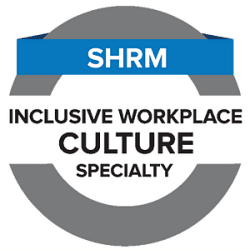
I’ve written before about how I’m not a “protester” when it comes to social issues. And I’m still not. But as I become more educated, I find that I’m getting bolder in expressing my thoughts. I’m sure that I’m not the only person who feels this way. Learning could be a way of gaining knowledge and beginning that journey toward showing more visible support.
A few of the topics that were covered during the seminar included:
Workplace culture changes over time. I thought this discussion was particularly relevant given everything we’re experiencing today. Organizations need to realize that their culture should and will evolve over time. That’s what makes company culture great – it’s ability to adapt.
There are levels of inclusion. It’s important for us to realize that inclusion takes on many mindsets including respect, safety, empowerment, and more. An individual might feel safe at work but not empowered. Inclusion has nuances and organizations need to recognize this.
Inclusion efforts must be sustainable. What I mean here is that inclusion is something organizations should work at all the time. There’s no “We’ve reached inclusion. Our work is done.”. Organizations and individuals need to remember the importance of change and flexibility.
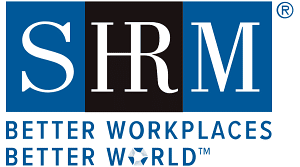
As organizations are talking with employees about returning to the office, use this as an opportunity to focus on inclusion. Yes, I’ll admit that Taco Tuesdays at the office is a nice perk. But more than the perks, employees want to work someplace where they feel included and valued. That’s what gets them back to the office.
I really enjoyed my experience earning the SHRM Inclusive Workplace Culture Specialty Credential. For HR professionals looking to help their organizations do less talking and more action when it comes to DEI&B, this might be a great place to start.
SHRM logo used with permission.
The post Organizations: Focus on Inclusion as Employees Return To the Workplace appeared first on hr bartender.
October 13, 2022
Bookmark This! Employee Mental Health Edition

Estimated reading time: 3 minutes
Earlier this week was World Mental Health Day. It reminded me of an article I read recently on SELF titled “50 of Our All-Time Best Mental Health Tips to Help You Feel a Bit Better”. The reason that I liked this very long list is because it gave me some suggestions for how to get myself unstuck. You know, if you’re having a bad day and the usual activities aren’t changing your outlook. Some of the activities are simply one-time things to do and others involve more of a long-term commitment. But there are plenty of activities to consider.
It reminded me how important making mental health a priority needs to be. Not just what we do on an individual level, but the emphasis that organizations need to place on employee mental health.
Employee Wellbeing Should Be Part of Your Organization’s Employment Brand
Many companies are looking for ways to stand out as an employer right now. Showing candidates and employees that the organization values wellbeing is a way to do it. The keyword here is “showing”. Don’t be afraid to make the wellbeing message part of the organization’s recruitment marketing strategy. It could be very helpful in attracting, engaging, and retaining talent.
Mental Health Benefits are a Key Part of the Employee Experience
Organizations really need to make sure their employees are in a good place. Because if managers and HR don’t feel like they can take care of themselves, how are they going to take care of the rest of the team?
Meditation: Consider Making it a Part of Organizational Wellbeing
As a human resources professional, having conversations about mental health and wellbeing can be a little intimidating. We might be saying to ourselves, “What if I say the wrong thing?” or “I’m in no position to help others because I need to get some help for myself.” That’s why we need to have more resources available and more conversations.
Goblin Mode in the Workplace Today
Allowing employees to be themselves is key to employee engagement and retention. And maybe that’s what workplace goblin mode is all about – allowing employees to be comfortable expressing their inner selves, including their weirdness, without criticism or consequences.
In a survey conducted by The Harris Poll, 67% of employees say mental health benefits are helpful. Organizations want employees to take care of themselves. It helps them perform better, which is good for everyone. This means that organizations need to consider offering, promoting, and openly supporting employee mental health benefits.
Image capture by Sharlyn Lauby while exploring the streets of Las Vegas, NV
The post Bookmark This! Employee Mental Health Edition appeared first on hr bartender.
October 11, 2022
Earned Wage Access: An Important Factor in Financial Wellbeing

Estimated reading time: 5 minutes
(Editor’s Note: Today’s post is brought to you by our friends at Wisely® by ADP , a suite of cost-effective pay solutions that helps organizations move to 100% paperless pay. The myWisely app has been recognized as the App of the Year at the HR Technology Conference . Congrats! Enjoy the article.)
A few weeks ago, I published an article about the benefits of offering earned wage access (EWA) to employees. I really hope you’ll go back and check out the article. Just as a reminder, EWA refers to an employee’s ability to access their earned wages prior to the next pay cycle. It’s not a pay advance or loan. The idea behind EWA is to give employees access to money they’ve already earned.
Let me say this again. EWA is not a payday loan. There are no interest charges and in most EWA program models, there is no fee. Employees are simply gaining access to the money they’ve already earned. Earned wage access is just one of the services available to employees via ADP’s Wisely app, a suite of digital financial wellness tools, that allow employees to receive their pay the way that works best for them.
I understand that earned wage access might be a relatively new concept. So today, I thought it might be helpful to elaborate on earned wage access. Specifically, what employees might use EWA funds for and why that’s an important factor in financial wellbeing.
In the ADP white paper “Earned Wage Access: Tapping into the Potential of Flexible Pay for Today’s World of Work”, they share some very interesting data about who uses EWA and for what reason. First, it’s important to note that 76% of employees in this study indicated that it was important for employers to offer earned wage access.
Interestingly, the ADP survey found that employees tended to underestimate how often they would use EWA, as compared to how often they actually use it when it is made available. 37% of employees who do not have access to EWA, estimated they would request an early payment only when a specific need occurred. 25% would use EWA one to six times a year, while 20% suggested they might use it every or every other pay period.
In reality, the majority of employees who have access to EWA indicate they request early access every or every other pay period (62%). Nearly a third said they used it one to six times per year, and 7% indicated that they used EWA when a specific need occurred.
Additionally, the usage of accessed early wages differs by age. Younger employees (age 18-24) tend to use it to reduce the stress of not having enough cash until payday. Those age 25 and older use it for family expenses and to pay bills to avoid late fees.
To me, that’s the reason earned wage access is such an important part of financial wellbeing. The Consumer Financial Protection Bureau (CFPB), a U.S. government agency focused of making consumer financial markets work for consumers, providers, and the economy, says that financial wellbeing means “being able to take control of your financial life and have financial peace of mind”. The CFPB goes on to say that financial wellbeing has four components:
Feeling in control, as in being able to cover one’s expenses.Capacity to absorb a financial shock, like a medical expense.On track to meet goals, whether it’s saving or reducing a debt.Flexibility to make choices, that allow someone to enjoy life.When we think about these four factors, earned wage access aligns with the four factors of financial wellbeing.
It allows employees to feel in control because they know EWA is there if they need it. And with Wisely by ADP app, they know they don’t have to pay a fee to use it. ADP’s survey data tells us that many employees use EWA to cover a family expense.Earned wage access can help employees pay their bills on time without incurring late fees.And finally, EWA can give employees the flexibility to make good financial choices.Now that we’ve talked about how financial wellbeing benefits employees. Let’s take a moment to discuss how it benefits companies. Because 85% of both employees and employers agree that financial wellbeing is important to overall wellbeing
From an organizational standpoint, 84% of employers believe offering financial wellbeing tools will help to attract talent. So, I’d like to think it goes without saying (but let me say it anyway), when organizations offer financial wellbeing tools (which employees want) and it helps to reduce financial stress (which no one wants), then that goes a long way toward employee retention (which organizations want).
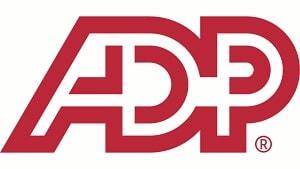
When and how employees get paid can be a strategic advantage in an organization’s recruiting and retention efforts. If you want to learn more about earned wage access, check out this ADP webinar on “Offering Earned Wage Access: Strategic & Compliance Considerations”. You can also download ADP’s latest white paper on “Earned Wage Access: Tapping into the Potential of Flexible Pay for Today’s World of Work”.
While organizations are always watching the economy, they might be doing it a bit more so right now. Even with economic uncertainty, it’s important to remember there’s still a very competitive jobs market. Organizations should be looking for ways to stand out with candidates and retain employees. I think it’s time to realize that employees want greater control over their money. They deserve it. And it’s good for them…and the company.
The post Earned Wage Access: An Important Factor in Financial Wellbeing appeared first on hr bartender.
October 9, 2022
What HR Should Know About Individual Coverage Health Reimbursement Arrangements
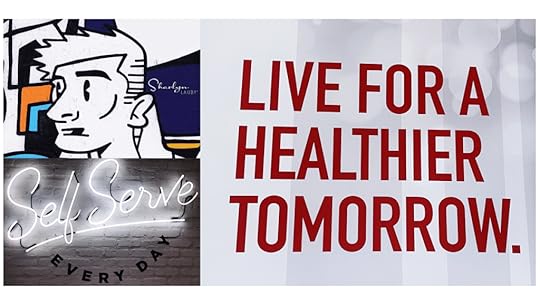
Estimated reading time: 8 minutes
We’re all reading the same stories about how competitive the recruiting landscape is these days. And how organizations are having to increase employee pay to attract and retain the best talent. One aspect that I’m not sure we’re spending enough time talking about is benefits.
Benefits play a key role in employee compensation according to a study by Prudential. And 73% of employees say benefits are a big reason they would stay at a job. One benefit that often stands out is health insurance. Employees want to know that they have good health insurance for both preventative care as well as an emergency need.
If you’re not aware, there’s a new type of health reimbursement arrangement called the individual coverage health reimbursement arrangement or ICHRA. It’s not the same as a health savings account (HSA) or flexible spending account (FSA). An ICHRA allows employers to reimburse employees for some or all the health insurance premiums that they purchase on their own.
To learn more about ICHRAs, I asked Cory Jorbin from HUB International to join us. Cory is the chief compliance officer in HUB’s employee benefits west region. In his role, he provides day-to-day compliance support to account teams and clients of all sizes on employee benefits such as the Employee Retirement Income Security Act (ERISA), the Affordable Care Act (ACA), The Health Insurance Portability and Accountability Act (HIPAA), the Family and Medical Leave Act (FMLA), cafeteria plans, and other related matters. Cory is a licensed attorney in the State of Illinois and is admitted to practice before the U.S. Tax Court.
Please remember that Cory’s comments shouldn’t be construed as legal advice or as pertaining to any specific factual situations. If you have detailed employee benefit questions, they should be addressed directly with your benefits broker or friendly neighborhood labor and employment attorney.
Cory, thanks for being here. Tell us what an individual coverage health reimbursement arrangement (ICHRA) is and how it differs from a health reimbursement account (or HRA)?
[Jorbin] An Individual Coverage Health Reimbursement Arrangement (“ICHRA”) is an employer funded account which employees use to purchase individual health insurance coverage. It replaces a traditional group health plan. When employers offer a traditional group health plan, they select the network and plan design and contribute towards the cost of coverage. An ICHRA allows employers to contribute to the cost of coverage but allows employees to choose their own network and plan design.
Is there a typical organization that finds an ICHRA popular – i.e., organization size, industry, geographic region, etc.?
[Jorbin] ICHRAs can be a good fit for any organization, however certain organizations may find an ICHRA to be especially advantageous.

Employers with employees in multiple states, and employers with a significant population in a single state, plus employees in other states. In the group insurance market, the employer chooses the network, and this may not be the preferred network in all areas where the employer has employees. As network coverage and preference can vary by region, an ICHRA allows employers with employees in multiple states to allow their employees to purchase the coverage with the network access they want.
The ICHRA rules also allow employers to continue to offer a group plan in certain markets while offering an ICHRA in other markets. If an employer is based in a certain state, they may wish to keep their group plan for employees in that state. If they also have employees in other states (which has become more common since the pandemic began), offering an ICHRA to employees outside the employer’s home state allows those employees to purchase the coverage with the network access they want.
Employers with high turnover. With an ICHRA, the underlying health coverage belongs to the employee rather than the employer. Therefore, if the employee separates from the employer, they can keep their own individual coverage after separation. While many employers are subject to the Consolidated Omnibus Budget Reconciliation Act (COBRA) or state continuation provisions, these only allow former employees to continue their coverage for a limited amount of time following separation.
Employers who struggle with low plan participation. In the group market, insurance carriers require a certain level of minimum participation in the group health plan. If the plan is not able to meet the minimum participation requirement some carriers will decline to quote, while others may add additional charges to the rates. The ICHRA model allows employers to avoid minimum participation requirements.
Employers may have low participation but still meet the carrier’s participation requirements. These employers may also be good candidates to consider an ICHRA. Low participation may be driven by the plan having high rates. If this is the case, those who enroll in the plan may do so because they utilize the coverage and incur claims. The result is a cycle of adverse selection. Each year rate increases are driven by high utilization (and claims), which further limit participation. An ICHRA allows employers to break this cycle.
Employers who do not currently offer benefits. Many employers are struggling to attract and retain talent. An employer who does not offer benefits is at a competitive disadvantage for talent. At the same time, offering benefits can be costly. ICHRAs are a good way for employers who do not currently offer benefits to employees to at least offer something, while also managing their costs and not contending with carrier minimum contribution rules and participation requirements.
Let’s discuss the “why”. Name a couple of advantages for employers to offer an ICHRA. Are there any downsides to consider?
[Jorbin] There are several advantages for employers:
An ICHRA allows employees to choose the coverage and network they want, thus increasing choice for employees If an employer expands employee population into new geographic areas an ICHRA allows them to do so without changing current group plan, which can be (particularly valuable for employers with current health maintenance organizations (HMOs) and regional carriersAn ICHRA allows employers to more consistently manage costs without being at the mercy of medical claimsA few disadvantages for employers include:
An ICHRA is a change from what employees have come to expect from employers, so educating employees is critical.The employer has no control over what plan options employees will choose. Buyer’s remorse can be real, which again highlights the importance of education.Employers also have no ability to correct mistakes made by employees, such as policy cancellation due to non-payment of premiums.On the flip side, what are a couple of ICHRA advantages for employees? Any downsides employees need to think about?
[Jorbin] The advantages for employees include:
Employees can choose the coverage level and network they want and aren’t limited to the plan and networks chosen by employersEmployees and spouses/dependents can choose different networks or levels of coverage, which is not possible in the group market.Employees can directly impact their premium cost by choosing the plan that meets their medical and financial needs. For example, If the employer offers a group plan for $100 per month for employee only coverage, the employee is limited to this cost. With an ICHRA, an employee with minimal medical needs may be able to purchase a lower-level plan for only $50, while one with greater needs may be able to purchase a more comprehensive plan for $200 per month.The disadvantages for employees:
A paradox of choice where employees struggle to choose a plan given the number of options in certain areas. Note, even if employees don’t like the 2-3 group options offered by an employer, at least the employer has made the process of choosing a plan easier.Individual rates are driven by geographic rating areas and age. Therefore, rates can vary significantly by location, and older employees could likely pay more for coverage than under the current. Since the underlying coverage belongs to the individual rather than the employer, employees can’t rely on their employers to assist with claims or other coverage issues.
Last question. Many organizations use the fourth quarter as “open enrollment season”. Is an ICHRA easy to implement, meaning is this something organizations could act on this year or is it more of a next year project?
[Jorbin] January 1st is the best time to move to an ICHRA since all individual market plans renew on the calendar year. ICHRAs can be relatively easy to implement, however employers should act quickly if they are considering an ICHRA for January 1st.
Employers need to first determine whether the employer will administer the ICHRA themselves or utilize a third-party vendor. Next, they will need to establish ICHRA contributions and communicate this, along with the required notices to employees.
Finally, employees will need to enroll in individual coverage and work with the employer and/or vendor administering the ICHRA to understand payment processes. For coverage to be effective January 1st, employees must enroll by a certain date, which varies by state.
My thanks to Cory for sharing his knowledge with us. If you want to learn more about ICHRA plans, check out HUB’s “Straight Talk About ICHRAs” webinar recording.
Benefits are so important to organizations and individuals. But they can also be tricky to maneuver. It’s good to remember that we have options and to explore them. Because benefits are a great way for employers to stay competitive.
Image captured by Sharlyn Lauby while exploring the streets of Salt Lake City, UT
The post What HR Should Know About Individual Coverage Health Reimbursement Arrangements appeared first on hr bartender.
October 6, 2022
Employee Birthday Celebrations Should Focus On the Recipient [POLL RESULTS]

Estimated reading time: 3 minutes
A few weeks ago, I shared a reader note about employee birthdays and how difficult it can be to wish someone well. This reader was specifically looking for guidance about selecting birthday cards, but it made me wonder, how do people want to celebrate their birthday at work? Here’s what you said.

The top two choices were an office card and lunch with colleagues. Both have their advantages and disadvantages.
Office cards are a nice and inexpensive way to show someone you’re thinking of them. It could also be great for hybrid and remote workers. The downside is someone needs to be responsible for remembering birthdays, finding a card, and circulating it around the office. Maybe the office could buy some birthday cards in bulk and let employees use them. That makes the process easier and still allows employees to share their well wishes.
Lunch celebrations are good for building some camaraderie and celebrating someone’s special day. The downside is that lunch cost money. And organizations have to think about their remote workforce. Some employees might be watching their budget and not want to spend the money – even though they care about the person. Another dynamic that comes into the picture is what if someone doesn’t like the place chosen for lunch. One way to handle this is to order food instead of going to a restaurant. Then employees who bring their lunch can still join in the fun.
When we posted the original article with the poll, I heard from many people that some offices had a group vote to eliminate birthday celebrations, and everyone was thrilled. I also heard from people who said their offices gave responsibility for birthday celebrations to the recipient. If you wanted a celebration, then bring in cake or balloons or whatever. If you didn’t, then that’s fine too. It makes sense. Let the birthday person drive the celebration.
I know the reader note that prompted this conversation is just trying to be a nice co-worker and wish someone well on their birthday. And I’m sure some people are saying, this really isn’t that hard. But there are news articles about the employee backlash on “mandatory fun”. This kind of birthday recognition isn’t about the birthday person. It’s about the celebration and using an individual’s birthday as a way to build camaraderie – whether they want it or not! I wish there was an easy answer to celebrating birthdays. But throughout this entire conversation, I found myself thinking about one thing – a person’s birthday is about them and what they want. So maybe the answer is to just ask the person how they would like to celebrate.
Image captured by Sharlyn Lauby while exploring the streets of Gainesville, FL
The post Employee Birthday Celebrations Should Focus On the Recipient [POLL RESULTS] appeared first on hr bartender.
October 4, 2022
Include Ethics in Your Employment Branding
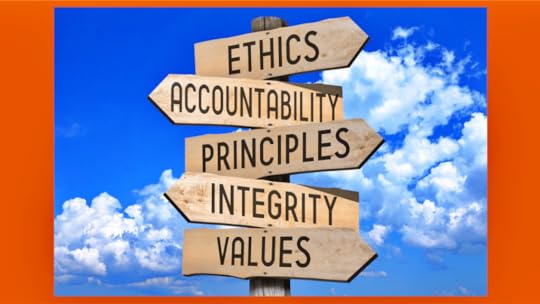
Estimated reading time: 5 minutes
(Editor’s Note: Today’s article is brought to you by our friends at i-Sight , a leading provider of case management solutions that helps companies manage the process and workflow of investigators collecting and analyzing information related to a case, with the goal of resolving issues, managing risk, and identifying opportunities for improvement. Enjoy the read!)
Regardless of what’s happening in the labor market, organizations need to have a well-defined employment brand. And they need to be regularly promoting it. According to research from Glassdoor, 92% of people would consider changing jobs to work at a company with an excellent reputation and 75% of job seekers are more likely to apply to an opening if an employer is active in maintaining their social profile. The bottom line is people want to work with companies they can be proud of. And a key component of that is to have a great employer reputation.
Creating a Great Organizational ReputationSo, what does it mean to have a great reputation? Well, this is one of those moments when I pull my marketing textbook off the bookshelf because we can look at classic marketing reputation management strategies for the answer. There are lots of long lists when it comes to building a reputation, but two qualities come up consistently.
ETHICS is defined as having a set of moral principles or values. Some common values include honesty, transparency, and truthfulness. CREDIBILITY refers to “doing what you say you’re going to do”. When you’re credible, people can trust you.My takeaway is that great reputations are ones where what the organization says (ETHICS) and the things the organization does (CREDIBILITY) are in alignment. For example, an organization’s code of conduct might include “treating others with dignity and respect”. Maybe the reality is that this doesn’t happen. So, the organization has a written code of ethics, but they don’t have credibility.
Let’s take it one step further. If there’s a disconnect between the organization’s code of ethics and their actions, the word will get out. It will be reflected in employee engagement surveys. It will contribute to employee turnover. And, it might show up on employer review sites, which could have an impact on future applicant flow.
There’s one other aspect of good reputations worth mentioning. It’s one we don’t like to talk about but, great reputations are often built when something bad happens like an ethics breach. How the organization conducts themselves demonstrates to employees (and customers) that the organization doesn’t just do the right thing when all is going well. It demonstrates that ethics is ingrained into organizational culture.
Therefore, organizations should include their ethics in their employment branding and be prepared to talk about it during the recruiting process. This lets applicants know what the organization stands for. It sends the message that ethics are important to the organization. Employees – and potential employees – want to know this.
Employees want to know that the company places an importance on maintaining a workplace free from discrimination and harassment. They want to know that the workplace is safe and secure. And finally, employees want to know that they won’t be spending their time dealing with the drama of ethical dilemmas. People already have enough going on without adding the stress of deciding whether to report someone to HR.
The reason including ethics in employment branding makes sense is because applicants and candidates can evaluate the company’s ethics before ever applying and during the interview process. Individuals can apply knowing that their personal ethics align with the company’s. During the interview, organizations can ask ethics related questions such as:
Have you ever encountered an ethical problem at work?Tell me about a time when you faced a moral or ethical dilemma.While the employee might not have numerous stories to share, asking these questions sends the message that ethics is important to the organization.Also remember that employees might ask the organization about ethics during the interview process. Particularly if the company has had a high-profile ethics breach.

Then, once an employee is hired, make sure that ethics is a key component of new hire orientation and onboarding. Consider having legal counsel conduct a webinar or podcast on the topic that all employees can access. And I know they’re not employees but also consider including ethics, especially conflict of interest, in contractor onboarding.
Ethical Brands Perform BetterSome people might be thinking, “Why should we promote ethics? Isn’t that a given?” And the answer is “no”. I’m not implying that any organization is unethical but that doesn’t mean we should assume that everyone knows our ethics as an organization.
Bringing ethics to the forefront of the organization’s employment brand not only contributes to better hiring, it also benefits the bottom line. In a comparison study between the 2020 Ethical Companies list and their competitors, it was discovered that ethical brands outperform their peers. I believe there’s a clear line of sight between ethics, attracting the best talent, and then best talent contributing to the bottom line. It totally makes sense. This is an opportunity to stand out by telling people what we stand for.
P.S. While I’ve mentioned having an ethics culture a couple of times today, I know we didn’t do a deep dive into how organizations can strengthen their ethics culture. Join me and the i-Sight team for a webinar focused on “5 Steps to Creating an Ethical Work Culture – and Expertly Responding to Incidents”. It’s scheduled for Thursday, October 27, 2022, at 2p Eastern. I hope you can attend. It’s going to be a very interesting conversation.
The post Include Ethics in Your Employment Branding appeared first on hr bartender.
October 2, 2022
Talking Taboo: A Framework for Having Polarizing Discussions at Work
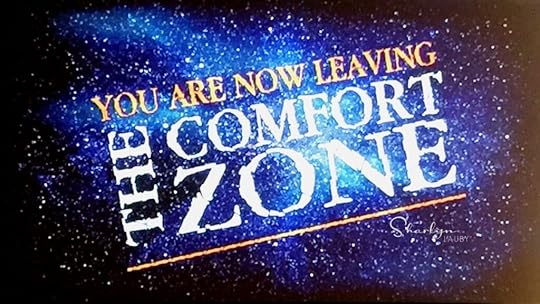
Estimated reading time: 6 minutes
At this year’s Society for Human Resource Management (SHRM) annual conference, there was a conversation about HR being able to “change the temperature” of the work environment. SHRM President and CEO Johnny C. Taylor, Jr. called it the difference between being a thermometer and a thermostat. Thermometers read the temperature. Thermostats change the temperature.
I was reminded of this conversation about thermometers and thermostats while I was reading Alexander Alonso’s latest book, “Talking Taboo: Making the Most of Polarizing Discussions at Work”. Alex is the chief knowledge officer at SHRM. In his role, he leads all research activities including the development of the SHRM competency model and credentials. I spoke with Alex last year about low empathy workplaces.
I asked Alex if he would chat with me again about “Talking Taboo” and thankfully he said yes. I believe trying to maneuver through conversations about politics, sex, race, and religion is becoming an issue for organizations and individuals. Knowing a good way to respond is something that individuals need to think about. And it’s possible that HR professionals will need to get involved.
Alex, thank you so much for being here. Some people might say if we stick to the advice of “Don’t talk about sex, religion, or politics at work.” then we don’t need to worry about “Talking Taboo”. I’d love for you to share why you decided to write this book.

[Alonso] I decided to write this book after a conversation I witnessed amongst my own team. Two of my team members were discussing the defund the police movement, but they were doing so in such an artful manner. Their interaction highlighted a component of civil discourse that I had rarely seen and only experienced in my Cuban upbringing – the fact that we all share a common objective at some point. This exchange started my thought process to what else might call for this in the workplace.
I’m going to play contrarian here. I could see people saying, “I do not have the time or the energy to wear a striped shirt and break up employee arguments about the last election or the current political scene.” Why are having these conversations important for HR from a business standpoint?
[Alonso] These conversations are essential for HR for a couple of reasons.
Many workers are already experiencing this. Our research shows that 92% of workers have witnessed or been a part of taboo topics. Not only is taboo talk already happening, but without a firm hand to steer the conversation, it can also divide teams. Our workplace culture report announced that 42% of respondents witnessed insensitive or inconsiderate treatment in the past year.Managers need to recognize this and know how to step in and manage these situations instead of simply telling people not to engage in these topics.
“Talking Taboo” introduces the Me + We + WO + RK framework. I understand that we can’t cover everything here – people should buy the book – but tell us a little bit about the framework and its purpose.
[Alonso] The Me + We + WO + RK framework is important because it’s a tool for managers to script discussions and structure. It enables parties to have room to speak while also not allowing them to hurt others in the process. This framework allows parties to mitigate problems as they occur and as a debrief method for individuals to learn in the future.
One of the conversations I’m hearing more often is a “hopelessness”. Meaning that the polarization appears to be so vast, that there’s no way to a resolution. Are there topics or situations where “no resolution” is an option? If so, how do people still work together knowing there’s a deep divide?
[Alonso] From my experience, there shouldn’t be any situations where issues can’t be resolved if a company’s culture supports its employees.
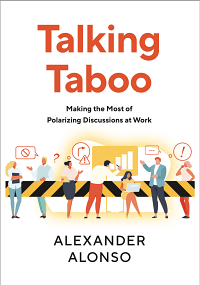
“Talking Taboo” shows that it is important to be respectful, acknowledge the reality that the divide exists, and respect each other for those opinions. Employees need to see their colleagues as people, not simply as adversaries of a particular point of view. In Chapter 5 (Politics in Broadcast and Social Media), one example is given resolving a heated disruption; in this instance, HR focused on behavior rather than the subject of the disagreement.
Behavior is the key element since discussing these topics can disrupt everyone’s ability to work. HR can recommend that certain divisive topics be limited or discouraged from conversation in these instances.
Last question. I can see some HR pros wanting to read “Talking Taboo”, share the framework, and encourage conversations. Are there any suggested prerequisites? For example, should HR pros think about designing interventions to address these topics versus just allowing for organic conversations? And on an individual level, should people heighten their awareness of empathy, change management, etc. before engaging in conversations?
[Alonso] I don’t believe there are any prerequisites to reading this book. This book can benefit anyone: from individual employees trying to be more mindful of their behavior to people managers and HR professionals who may need to step in during a heated exchange.
While conversations will undoubtedly spring up, it may help HR departments have an action plan of what behaviors to look for and creative ways to foster empathy in the workplace.

A huge thanks to Alex for sharing his knowledge and experience with us. You can find “Talking Taboo” in the SHRM bookstore or on Amazon along with his other book “The Price of Pettiness”.
There are plenty of headlines talking about how divided individuals are on topics related to politics, sex, religion, and race. And just as a personal observation, people seem to want to discuss these topics. So, we can’t simply ignore it. From an individual perspective, it might make some sense to think about how you want to engage. And from an HR perspective, it makes a lot of sense to prepare for facilitating those discussions in the workplace.
Society for Human Resource Management (SHRM) logo used with permission.
The post Talking Taboo: A Framework for Having Polarizing Discussions at Work appeared first on hr bartender.
Sharlyn J. Lauby's Blog
- Sharlyn J. Lauby's profile
- 10 followers



